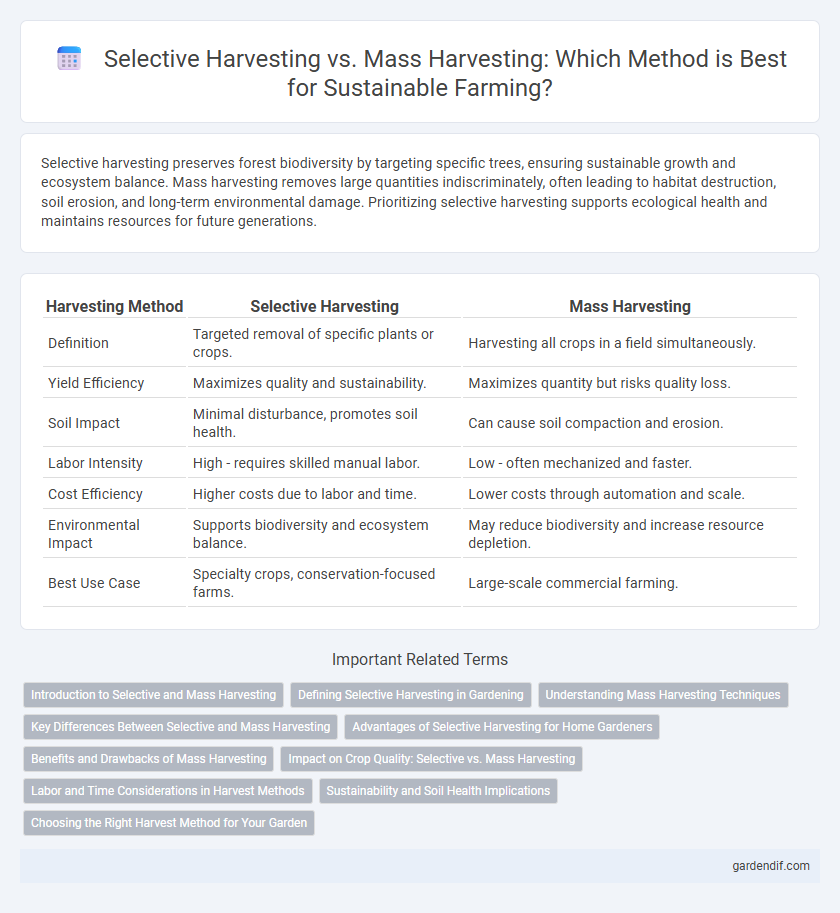
Selective Harvesting vs Mass Harvesting Illustration
Selective harvesting preserves forest biodiversity by targeting specific trees, ensuring sustainable growth and ecosystem balance. Mass harvesting removes large quantities indiscriminately, often leading to habitat destruction, soil erosion, and long-term environmental damage. Prioritizing selective harvesting supports ecological health and maintains resources for future generations.
Table of Comparison
| Harvesting Method | Selective Harvesting | Mass Harvesting |
|---|---|---|
| Definition | Targeted removal of specific plants or crops. | Harvesting all crops in a field simultaneously. |
| Yield Efficiency | Maximizes quality and sustainability. | Maximizes quantity but risks quality loss. |
| Soil Impact | Minimal disturbance, promotes soil health. | Can cause soil compaction and erosion. |
| Labor Intensity | High - requires skilled manual labor. | Low - often mechanized and faster. |
| Cost Efficiency | Higher costs due to labor and time. | Lower costs through automation and scale. |
| Environmental Impact | Supports biodiversity and ecosystem balance. | May reduce biodiversity and increase resource depletion. |
| Best Use Case | Specialty crops, conservation-focused farms. | Large-scale commercial farming. |
Introduction to Selective and Mass Harvesting
Selective harvesting targets specific trees based on criteria such as species, size, and health, promoting forest regeneration and biodiversity. Mass harvesting involves the removal of the majority or all trees in a designated area, maximizing immediate timber yield at the expense of ecological balance. Understanding the differences in impact and methodology between selective and mass harvesting is crucial for sustainable forest management.
Defining Selective Harvesting in Gardening
Selective harvesting in gardening involves carefully choosing ripe fruits or vegetables to pick individually, ensuring the rest of the plant continues to grow and produce. This method promotes sustained yield, reduces waste, and maintains plant health by minimizing damage during harvest. Unlike mass harvesting, selective harvesting enhances quality control and allows gardeners to extend the harvesting period across multiple cycles.
Understanding Mass Harvesting Techniques
Mass harvesting techniques involve the rapid collection of entire crop fields or large quantities of products simultaneously, maximizing efficiency and reducing labor costs. Mechanical harvesters, such as combine harvesters for grains or automated fruit pickers, are commonly used to expedite the process and increase yield output. This approach is ideal for monoculture farms where uniform crop maturity allows for synchronized harvesting, but it may lead to increased waste and reduced quality control compared to selective harvesting methods.
Key Differences Between Selective and Mass Harvesting
Selective harvesting targets specific trees or crops based on maturity, health, or species, promoting sustainable yield and biodiversity conservation. Mass harvesting involves the removal of all or most vegetation in an area, maximizing immediate output but often resulting in ecosystem disruption and soil degradation. The key differences lie in ecological impact, resource efficiency, and long-term environmental sustainability.
Advantages of Selective Harvesting for Home Gardeners
Selective harvesting allows home gardeners to pick ripe fruits and vegetables as they mature, ensuring optimal flavor and nutritional value. This method reduces waste by avoiding the collection of unripe or damaged produce and promotes continuous growth throughout the season. Furthermore, selective harvesting supports plant health by minimizing stress and encouraging prolonged productivity in home gardens.
Benefits and Drawbacks of Mass Harvesting
Mass harvesting enables rapid collection of large crop volumes, boosting short-term productivity and reducing labor costs. However, it often leads to resource depletion, increased waste, and environmental degradation due to its non-discriminatory approach. This method can compromise long-term sustainability and soil health compared to selective harvesting techniques.
Impact on Crop Quality: Selective vs. Mass Harvesting
Selective harvesting enhances crop quality by allowing only ripe and healthy produce to be gathered, reducing damage and ensuring better flavor and nutritional value. Mass harvesting often results in collecting immature or overripe crops, leading to inconsistent quality and increased post-harvest losses. The precision of selective harvesting supports premium market standards and minimizes waste compared to the broad approach of mass harvesting.
Labor and Time Considerations in Harvest Methods
Selective harvesting demands intensive labor and extended time as workers carefully pick only mature or high-quality crops, ensuring minimal damage and sustainable yield. In contrast, mass harvesting relies on mechanization or large-scale manual efforts that significantly reduce labor hours and accelerate the overall harvesting process, but may compromise crop quality and increase waste. Efficient labor allocation and timing must balance the goals of productivity and crop preservation in choosing between these harvest methods.
Sustainability and Soil Health Implications
Selective harvesting preserves ecosystem balance by allowing mature plants to regenerate, promoting long-term soil fertility and reducing erosion risk. Mass harvesting often leads to soil degradation, nutrient depletion, and increased susceptibility to pests due to the complete removal of vegetation cover. Sustainable agriculture favors selective methods to maintain soil structure and biodiversity, ensuring productive land use over multiple growing cycles.
Choosing the Right Harvest Method for Your Garden
Selective harvesting targets only ripe fruits or vegetables, promoting continuous growth and reducing waste, making it ideal for gardens focused on sustainability and quality yield. Mass harvesting involves gathering all produce at once, which can maximize short-term output but may stress plants and reduce long-term productivity. Choosing the right harvest method depends on crop type, garden size, and desired harvest frequency to optimize both plant health and harvest efficiency.
Selective Harvesting vs Mass Harvesting Infographic

 gardendif.com
gardendif.com